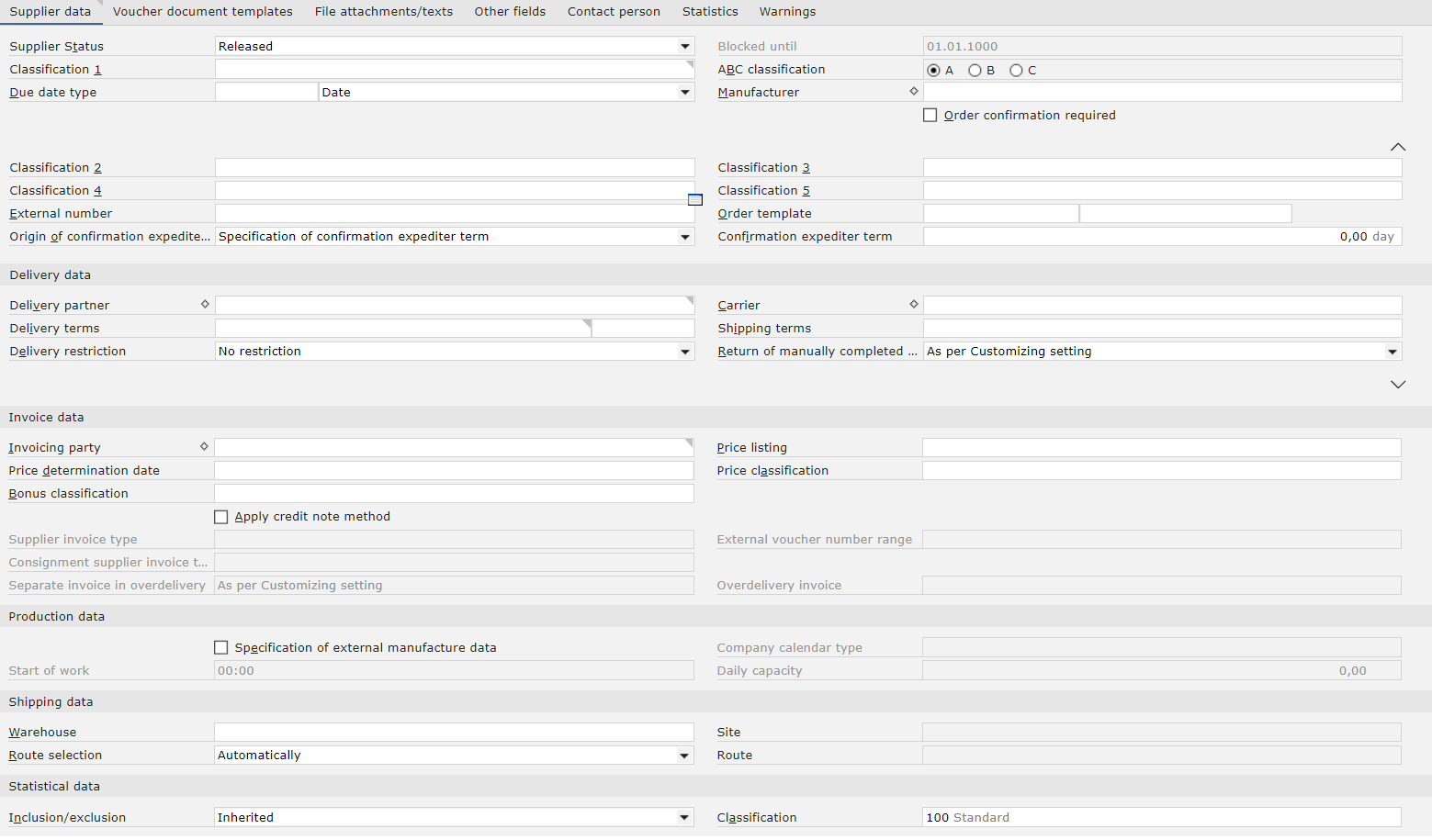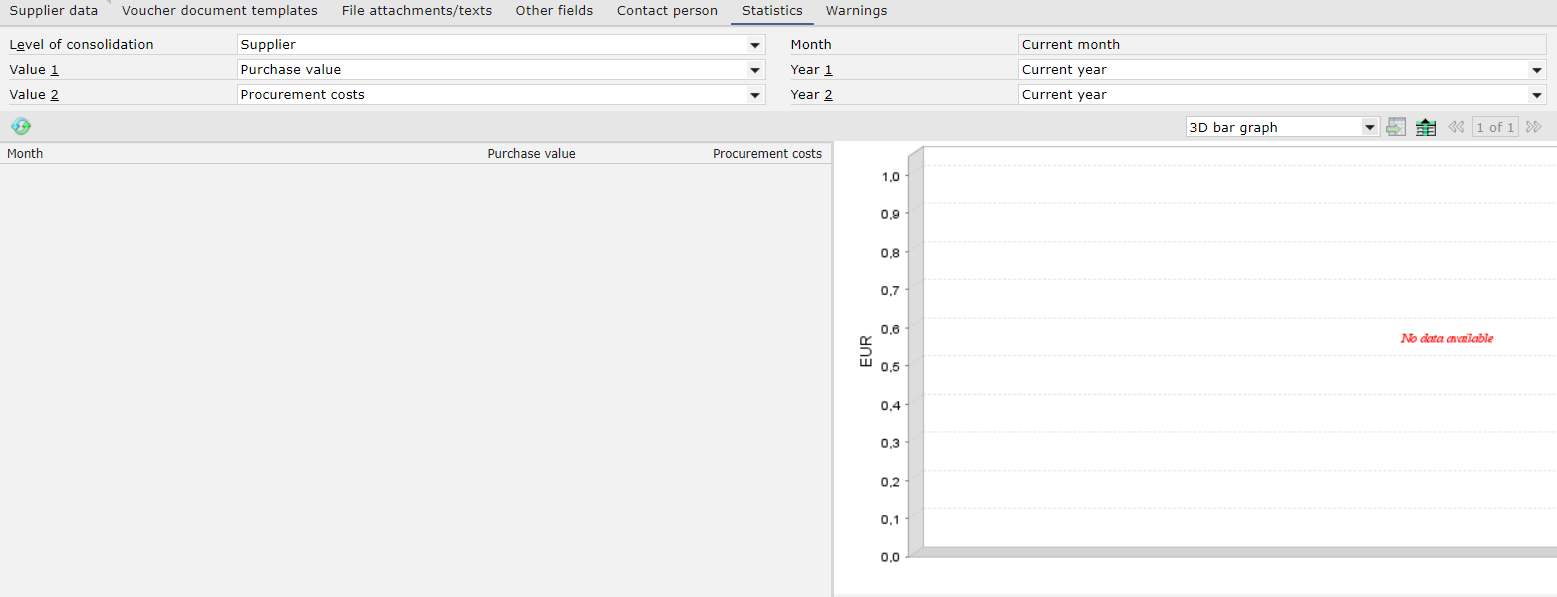Topic overview
The following article contains information on the Supplier view of the Partners application.
Detailed information on the Partners application may be found in the article Partners.
Work pane, Supplier view
The Supplier view is composed of the following tabs:
- Supplier data
- Voucher document templates
- File attachments/texts
- Other fields
- Contact person
- Statistics

Supplier data tab
The Supplier data tab allows the user to enter, display, and edit supplier data.

- Supplier Status – this field makes it possible to select a status for the Supplier role:
- Released
- Blocked
- Blocked until – this field is active if the status Blocked has been selected and it makes it possible to enter a date until which the Supplier role is to be blocked
- Classification 1 – in this field, it is necessary to select a classification to which the supplier is to belong
- ABC classification – it is an additional classification indicating whether a given supplier is used frequently (A) or rarely (C). This classification is informative only.
- Due date type – the selection of a due date type determines the format of a preferred date in purchase orders. Available options include:
- Timestamp
- Date and time
- Date
- Period
- Calendar week
- Month
- Quarter
- Year
- Manufacturer – this field makes it possible to enter a manufacturer
- Order confirmation required – selecting this parameter automatically selects the corresponding parameter in the Purchase orders application; the parameter is used to verify whether order confirmations are required for purchase order and order confirmation documents
- Classification 2-5 – additional classifications
- External number – the supplier’s number/identification allowing the user to distinguish the supplier from a partner’s identification, e.g. in documents
- Order template – a selected template is used to create orders more quickly
- Origin of confirmation expediter term – this field controls the function of the Confirmation expediter term field; available options include:
- As per Customizing setting
- Not applicable
- Specification of confirmation expediter term
- Confirmation expediter term – it is a period used when sending a reminder for overdue order confirmations. The field is active if the Specification of confirmation expediter term option has been selected in the Origin of confirmation expediter term
Delivery data section
This section makes it possible to enter delivery data.

Available fields include:
- Delivery partner – a partner sending items to the delivery recipient as part of the purchasing process. A single supplier may be associated with several delivery partners.
- Carrier – in this field, the user can select a carrier responsible for the transport of items
- Delivery terms – this field makes it possible to enter terms agreed upon by the buyer and seller. They are used to determine the type and location of delivery.
- Shipping terms – this field makes it possible to enter terms agreed upon by the buyer and seller. They are used to determine how items are shipped.
- Delivery restriction – restrictions to be applied in purchase documents:
- No restriction
- Deliver order in full
- Deliver line items in full
- Return of manually completed line item – it determines whether delivery completion is to be kept and whether it should be processed:
- As per Customizing setting
- Remove completion
- Keep and deliver completion
- Keep and do not deliver completion
Invoice data section
In this section, the user can enter additional descriptions of the partner. They are usually used in document printouts.

- Invoicing party – it is a party issuing invoices; by default, the current partner’s identifier is entered in this field
- Price listing – whose order is defined by means of priorities
- Price determination date – it is a date falling within the price listing’s effective period
- Price classification – it is used to group partners for whom the same purchase prices are used
- Bonus classification – it is used for the purpose of bonus agreements for suppliers whose bonuses are set on the same basis, i.e. not at the level of an individual supplier
- Apply credit note method – selecting this parameter allows the use of credit note payments
- Supplier invoice type – this field is activated after the selection of the Apply credit note method The field makes it possible to assign a supplier invoice type for this method of payment settlements
- External voucher number range – this field is activated after the selection of the Apply credit note method The field makes it possible to assign a number range to be used for the generation of an external voucher number for this method of payment settlements
- Consignment supplier invoice type – this field makes it possible to assign a consignment supplier invoice type
- Separate invoice in overdelivery – this field determines how to handle overdelivery. Available options include:
- As per Customizing setting
- None
- For each different receipt of goods line item
- Summarized by receipt of goods voucher
- Overdelivery invoice – this field makes it possible to define the invoice type for overdeliveries
Production data section
Data from this section is used in external production processes for the determination of the supplier’s capacity, so that it is possible to calculate an operation’s completion time.

Available fields include:
- Specification of external manufacture data – selecting this parameter activates the remaining fields in this section and allows the user to enter detailed information
- Company calendar type – it helps in determining the working days of an external manufacturer
- Start of work – it defines the time when the external manufacturer starts work on a working day
- Daily capacity – in this field, it is possible to enter the working capacity of the external manufacturer
Shipping data section

Available fields include:
- Warehouse – a warehouse to which the partner is to deliver items
- Site – this field is activated after selecting the option Manual in the Route selection field and it makes it possible to select a site to which items are to be delivered
- Route selection – routes are managed using the Inventory Management framework and are based on sites; available options include:
- Automatically
- Manual
- None
- Route – this field is activated after selecting the option Manual in the Route selection field and it makes it possible to select a route identification defined in the Routes application in the Inventory Management framework
Statistical data section

Available fields include:
- Inclusion/exclusion – this field determines the inclusion of supplier invoices in statistics; available options include:
- Inclusion
- Exclusion
- Inherited (default)
- Classification – a classification hierarchy used for statistical purposes
Voucher document templates tab
This table makes it possible to adjust settings for relevant voucher document templates for the supplier.

The table is composed of the following columns:
- Voucher category – in this column, the user can select a voucher document category for which additional settings are to be defined
- Medium – in this column, it is necessary to select a device that will be used to enter a voucher document category, e.g. Printer, E-mail, Fax
- Voucher document template – it is selected from a list whose items are defined in the Voucher document templates application
- Recipient addressing – an address that will be used in an issued document
- Preferred – activating this parameter defines the preferred voucher document template
File attachments/texts tab

The work pane is divided into tables composed of the following columns:
- Number – the number of an added attachment
- Voucher category – in this column, it is necessary to select a voucher category to which the attachment is to be added, e.g. an order or contract
- Attachment/text category – it is a category attached to the voucher document, e.g. Header text, Footer text, Item text, E-mail file attachment
- Text module – in this column, it is possible to select a previously entered text module. Text modules may be entered in the Text modules application in the Base framework
- Attachment/Text
Above the table, there is a language selection menu, allowing the user to save content in a selected language.
Other fields tab
The Other fields tab allows the user to enter additional fields, e.g. if such user-defined fields are required to provide additional information. User-defined fields are associated with a business object; therefore, they must be defined independently in all views.

Contact person tab
This tab makes it possible to enter a contact person for the Supplier view classification.

Statistics tab
This tab displays the purchasing statistics of the supplier. The supplier statistics make it possible to analyze turnover generated by the supplier.

Available fields:
- Level of consolidation – this field allows the user to enter the level of consolidation of the statistics; available options include:
- Supplier
- Supplier + Item
- Supplier + Item statistics classification
- Month (non-editable) – it displays the default value, that is Current month
- Value 1 – in this field, a reference value to be displayed in statistics needs to be entered; available options include:
- Purchase value
- Procurement costs
- Value 2 – in this field, the user can select another reference value
- Year 1 – in this field, it is necessary to enter a reference year for which statistics are to be displayed
- Year 2 – in this field, the user can enter another reference year, owing to which it is possible to view the increase in turnover compared to the previous year
